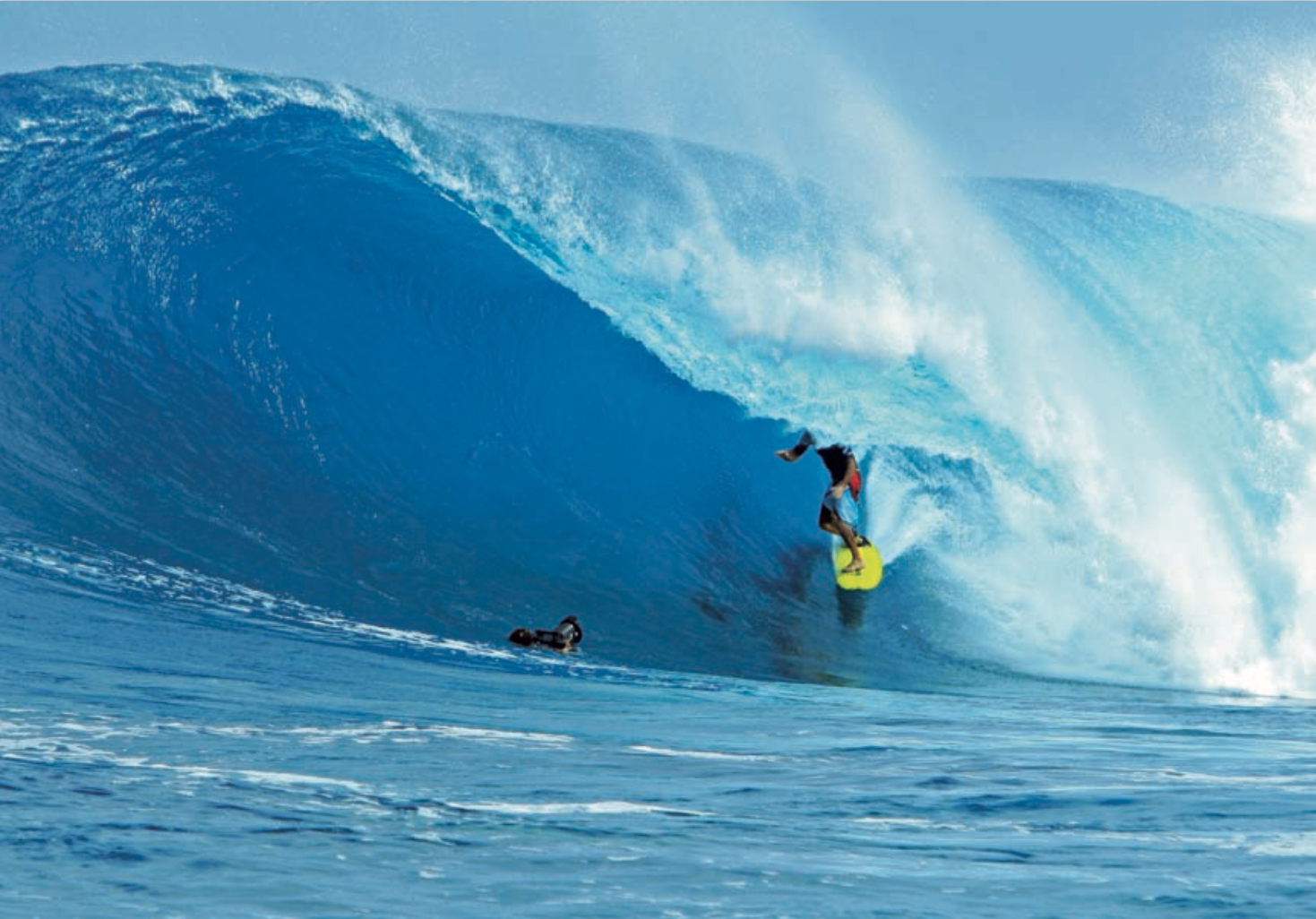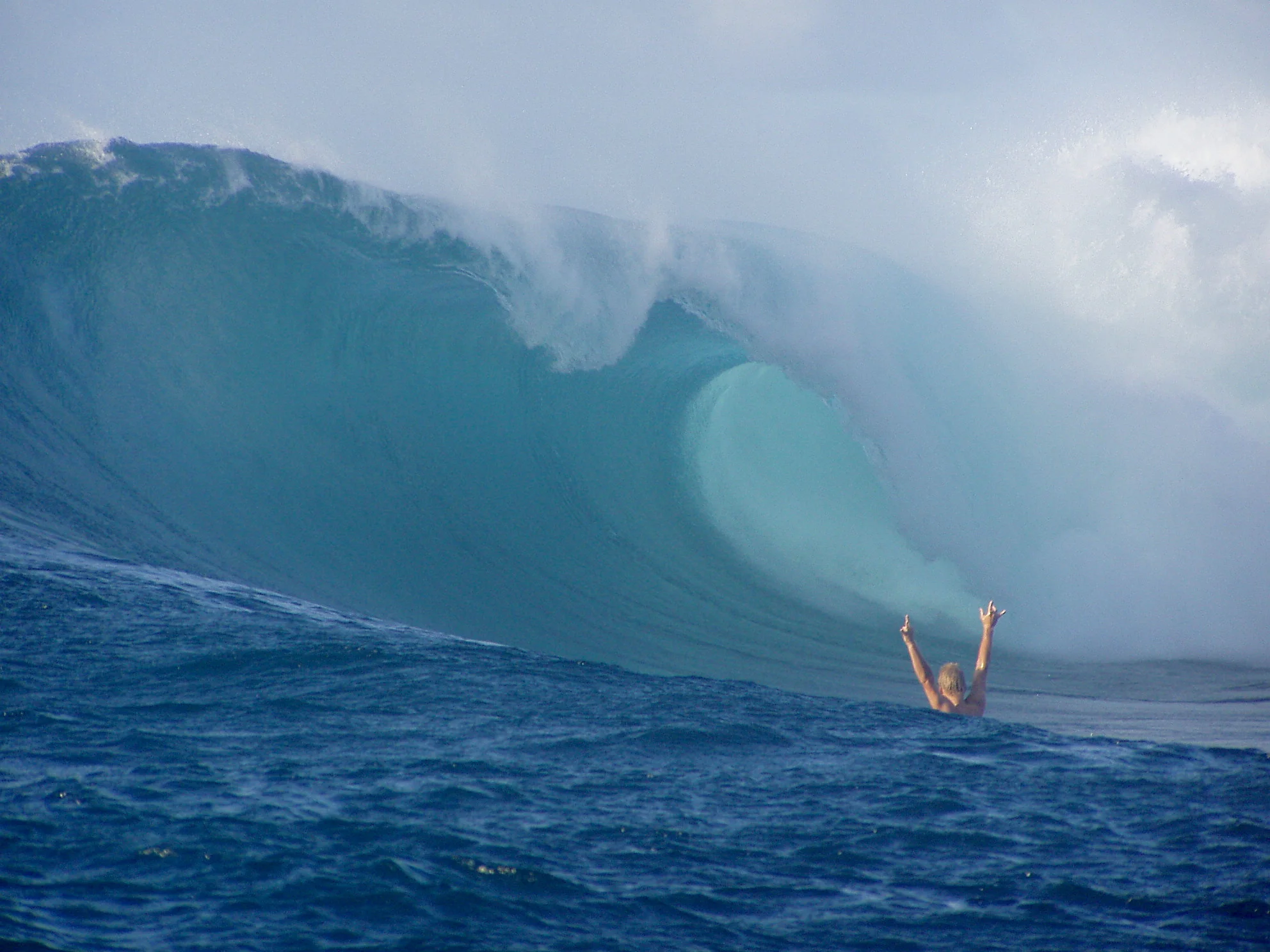Pohnpei | Part 3 | The Murmurs
By Michael H. Kew
NEAR 2 P.M. ON February 19, 2000, Rob Gilley aimed his telephoto Canon lens off the bow of Smell the Glove, Mike Sipos’s 17-foot Boston Whaler Montauk®. The boat was named after a Spinal Tap song and the Pohnpeian practice of wearing a fish-stenched glove to pull lines from the water.
Click-click-click.
Gilley was shooting something special.
Click-click-click-click.
July—five months later. It was in every surf shop, bookstore, and Muzaked 7-11. “Dan Malloy in the secret South Pacific” was the small incorrect (Pohnpei is in the North Pacific) caption on the lower left corner of the cover of Surfer’s annual oversized summer issue, 316 pages of “Epic Surf Adventure” crowned with Gilley’s photo of the California regularfoot gouging the back half of his surfboard into a tropical-blue right wall, the lip line behind him cradling a perfect tube. Inside the magazine was a 12-page feature called “Simple Procedure,” written and shot by Gilley, showcasing the young Malloy and his Laguna Beach goofyfooted friend Mike Todd trading perfect barrels alone at the same “secret” spot. Gilley, one of the best in the business, had woven a new dream for readers worldwide.
We wanted to know where the wave was. It was in the Pacific, but the almond-eyed islanders in Gilley’s photos precluded the wave from being Melanesian. And the island was rugged—Gilley didn’t visit an atoll, so that nixed Kiribati and the Marshall Islands. Polynesia? Perhaps. But Gilley said English was the island’s national language, and that disqualified everywhere between New Caledonia and the Archipiélago de Juan Fernández.
In the story Gilley wrote about going to Barnes & Noble, where he’d found just one travel book about “the area,” so I too visited Barnes & Noble to view its Pacific titles. Only one was about Micronesia; English-speaking bits of Micronesia were the Republic of Palau, the Territory of Guam, the Commonwealth of the Northern Marianas, and the FSM. I knew Gilley’s shots weren’t of Guam, because Guam had an active surf population. Later, my friend in Palau confirmed no pro surfers had been there, and suggested Gilley’s shots were likely from the FSM—Pohnpei, to be exact.
In March 2002 I was in the lunch room at Surfer awaiting a slide show by then-photo editor Jason Murray. Sam George, and Ross Garrett were there chatting with Surfer’s then-associate editor Carl Friedmann about a solo trip he’d just taken, something about a perfect right-hand barrier reef pass bowl off a mysterious Micronesian isle. At a pause in the conversation, I asked: “Where’d you go, Carl?”
“Pohnpei.”
“Good?”
“Yeah.”
The lights dimmed and slide show began. Friedmann left midway through. That night, I emailed Dan Malloy.
“It was Pohnpei,” he replied. “The wind can be bad, but if you get it clean, you’re in for a treat.”
Shawn Shamlou, an environmental project manager from San Diego, flew to Pohnpei with his artist friend Michael Cassidy in February 2003. Their trip resulted in an eight-page The Surfer’s Journal feature called “Meganesia” and it was the first media exposure of Palikir Pass since Gilley’s in Surfer four years prior. “It doesn’t matter where it is, though, even if I told you,” Shamlou wrote in TSJ. “Know why? Because you are not going there…(it’s) one of those places that’s too expensive to justify in light of other more dependable wave zones…Aussies won’t come here; Indo is closer and tremendously cheaper and more consistent.”
Page 57 of Shamlou’s article showed a photograph of Sokehs Rock, a famous Pohnpei landmark, proof of his story’s locale. Also included were four photos from Gilley’s 2000 Surfer trip. But how did Shamlou find Palikir? “I figured it out from a Nature Conservancy magazine,” he told me. “The airport, lagoon, and steep topography were big clues. Around the same time, Cassidy had been wanting to explore Micronesia, and we agreed Pohnpei would be worthy. Gilley’s Surfer article confirmed it.”
“Gilley was in a skiff he had hired, holding a camera, when Sean Stratton and I pulled up in my Whaler late one weekday afternoon,” Sipos told me. “Dan and Mike Todd were the only guys out. I yelled to Gilley that he was breaking my heart, and that his group was the first time I’d encountered other surfers in the water since my arrival almost two years before.”
Sipos paddled out and chatted amicably with Malloy and Todd; they and Gilley later dined with Sipos at his home near Kolonia. “I filled them in on the whole deal after Rob agreed that they would all keep it under wraps, which they did,” Sipos said. “I showed them videos and stills, the whole shebang. Those guys embodied what surfing and surf travel should be about, and I was glad to share it with them.”
Via Gilley, Shamlou contacted one of the Pohnpei surfers mentioned in Surfer: Mike Sipos, though Gilley did not write his last name in the article. In TSJ Shamlou referred to Sipos as “Jude,” Sipos’s middle name. I asked Shamlou for “Jude’s” email address, and on the grounds of secrecy, Sipos said he would be happy to meet me and take me out to surf Palikir.
In the late 1990s Gilley was Surfer’s photo editor; he’d tracked the Pohnpei scent from inside the magazine’s drafty gray San Juan Capistrano warehouse—all editions of the now-defunct Surf Report lay within. On lunch breaks Gilley ditched his light table for the steel shelves to lose himself in the printed-guide world of waves. Naturally he saw the Surf Report’s February 1998 issue about Pohnpei, written and photographed by a Kiwi named Russell Hill. Hill’s spot descriptions were grossly inaccurate—he even named a spot after himself, one Bruce Talley and others had been riding for years. He also claimed Pohnpei’s best surf season was summer.
South swells in Pohnpei are rare—the Solomon Islands and Papua New Guinea are in the way. The calmest months are August and September, when Pohnpei has light wind patterns and plate-glass seas unless tropical disturbances sweep by. Autumn is transitional, with intensifying rain, wind, and swell, which almost never arrive until Halloween. Winter is windy, with sustained trades from the east or northeast in the 20 mph range almost every afternoon. Unfortunately the windiest season coincides with the biggest swells; onshores for most spots are the norm, and the rainfall can be overwhelming.
Though the Surf Report described eight surfable reef passes, only one of them would be considered real. “The other spots,” Sipos told me, “are either too far away, too windy, too inconsistent, too shallow, unmanageable because of tides, currents, and boat anchorage/access issues, or unworthy as to wave shape. Whereas Palikir Pass is the gem from all angles and is so much better than every other spot. It is the magnet, and in reality is the only ‘true’ surf spot on Pohnpei.”
Rob Gilley knew this. Augmenting intel from a Tavarua boat driver who’d competed in a Pohnpei fishing tournament, there was the conversation with his Oceanside, Calif.-based dentist. A diehard scuba enthusiast, Dr. Bridges had visited Pohnpei and to Gilley described the shapely waves he’d seen at Palikir, an obscure diver’s paradise with superior visibility and copious marine life, the pass itself more than a half-mile long and 135 feet deep at its center. The bottom was more than 300 feet deep on the outside, and the currents could be severe, especially during the large winter swell which transformed Palikir into a surfer’s paradise.
“Pohnpei opened the world to me,” Gilley said. “It made me realize most surfers were sheep, and what you really wanted to be was a shepherd. To paraphrase Ted Grambeau, anybody who thinks that all the best waves in the world have been discovered hasn’t been looking.”
Grambeau first went to Pohnpei in the late 1990s—maybe 1998. He doesn’t recall. But he was alone, just scouting the setups; he had many frequent-flyer points with Continental Airlines. “The surf was pretty good,” he said, “but it rained the whole time I was there. I then studied rainfall patterns of the area and found it was one of the wettest places on Earth. I shelved any immediate plans for a full-scale surf trip.”
Soon Grambeau saw Gilley’s Surfer article. “Straight away I knew where it was despite no indication given in the article,” he said. In January 2004 Grambeau photographed Mick Fanning surfing Palikir during a three-day trip urged by swell models. “With Fanning, it was just a quick raid, deliberately keeping it low-profile as there were already regular surfers from Guam and Australia and the U.S. by that stage. There was absolutely no advantage for me to pinpoint its location.” An eight-page feature called “Clean Getaway” graced Issue 189 (April 2004) of ASL; photo editor Lee Pegus and the cagey Grambeau tried to stump readers by including a portrait of wild-haired Papua New Guineans and an aerial photo of Chuuk’s barrier reef.
Five years earlier, another Australian surf magazine (Tracks?) had shown Pohnpei via photos of small waves shot in summer; the feature was unmemorable. And the sole prior surf-media mention of Pohnpei appeared in the April 1986 issue of Surfer—photographer Erik Aeder had island-hopped from Guam back to his home on Maui, spending a week on Pohnpei (in Surfer he called it “Ponape,” the island’s name until 1984). It was summer, so he saw no surf, though he had heard good things about it. In his mistitled article “Melanesia,” Aeder mentioned the ruins of Nan Madol and included a photo of women and handicrafts in Pohnpei’s Polynesian village of Pohrakiet. His surf photos were from a different island.
In the four-year gap between Gilley and Grambeau, besides Pohnpei residents, Mike Sipos estimated Palikir hosted fewer than a dozen solo travelers—guys like Shamlou, Cassidy, Tony Pittar, Eric Havens, Friedmann, and Fred Mendiola—plus the temporary expat surfers: Ryo Aoki and Koyo Matsudaira from Japan, Dodd, Schroer, Stratton, Shaun Simmons, Dennis Gearheart, and Tyler McAdam from America. “But I should clarify that none of the magazine exposure came about at my urging or insistence,” Sipos said. “I didn’t initiate any of it. The photographers, writers, and pro surfers came on their own and contacted me, not the other way around. It was called sharing stoke and spreading aloha, which is something I did for every visitor who came along including, most notably, Allois Malfitani.”


